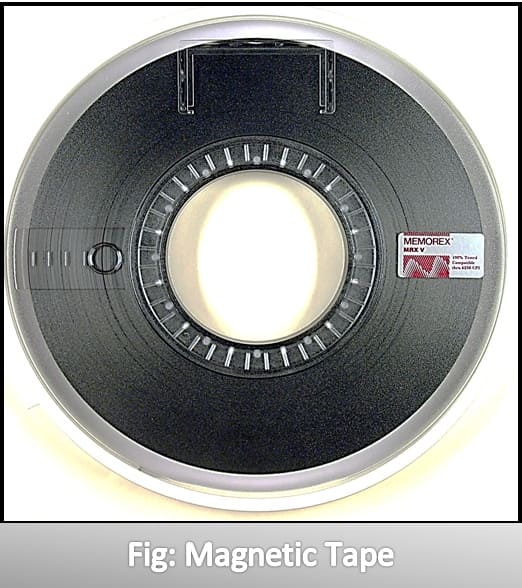Difference between Magnetic Disk and Magnetic Tape
Magnetic Disk:
A magnetic disk is a thin, circular metal plate. It coated with a thin magnetic film, usually on both sides. Digital information stored on the magnetic disk by magnetizing the magnetic surface in a particular direction. The data on the disks organized in a concentric set of rings. These concentric sets of rings are called tracks. Each track has the same width as the head and adjacent tracks separated by gaps.

The gap between two adjacent tracks prevents, or at least minimizes, errors due to misalignment of the head or simply interference of magnetic fields. Data bits are stored serially on each track. The same number of bits are stored on each track. Thus, the density, in bits per linear inch, increases as we move from the outermost track to the innermost track. The tracks are further divided into sectors. Each sector stores a block of data that can be transferred to or from the disk. To avoid magnetic interference between two adjacent sectors the gap introduced between two adjacent sectors.
Magnetic Tape:
Magnetic tape is one of the most popular storage mediums for large data that are very thin and 1/2 inch or 1/4 inch wide plastic tape. Usually, iron oxide used as a magnetizing material. The tape ribbon itself is stored in reels similar to the tape used on a tape recorder except that it is of high quality and more durable.

Like audio tape, computer tape can be erased and reused indefinitely. Old data on a tape are automatically erased as new data are recorded in the same area. The information recorded on the tape with the help of a reading/writing head. It magnetizes or non-magnetizes tiny invisible spots (representing 1’s and 0’s) on the iron oxide side of the tape.
Magnetic Disk vs Magnetic Tape:
| Parameter | Magnetic Disk | Magnetic Tape |
|---|---|---|
| Access | Direct | Sequential |
| Data transfer rate | More | Comparatively |
| Access time | Less | More |
| Reliability | More | Less |
| Portability | Less | More |
| Environmental Restrictions | Less | More |
| Cost | High | Less |
| Application | secondary storage device | backups |
